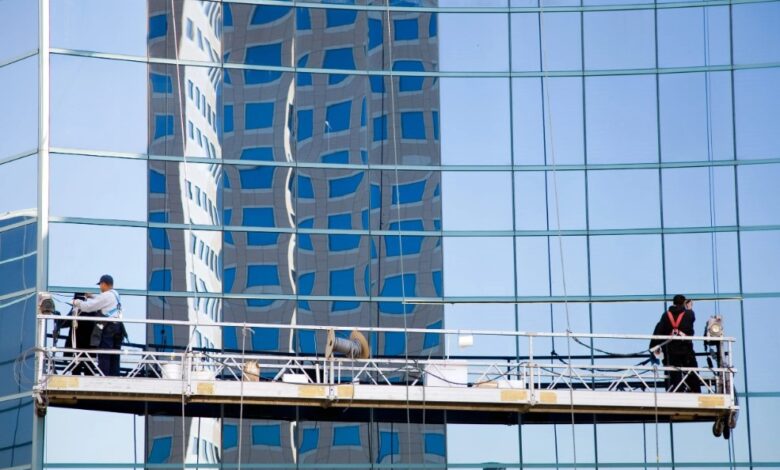Window Scaffolding Systems

Introduction to Window Scaffolding Systems
Challenges and Solutions for Using Window Scaffolding Systems in Extreme Weather Conditions
Window scaffolding systems are essential tools in the construction and maintenance of high-rise buildings. They provide a stable platform for workers to perform tasks such as window installation, cleaning, and repairs. However, these systems face significant challenges when used in extreme weather conditions. This article explores the key issues and solutions associated with using window scaffolding systems in harsh weather environments.
Understanding the Impact of Extreme Weather
Extreme weather conditions, including high winds, heavy rain, snow, and extreme temperatures, can pose serious risks to construction projects. These conditions can compromise the stability and safety of window scaffolding systems, endangering workers and potentially causing project delays. Understanding the impact of these weather conditions is crucial for developing effective strategies to mitigate risks.
Challenges of High Winds
High winds are one of the most common and dangerous weather conditions affecting window scaffolding systems. Strong gusts can cause scaffolding to sway or even collapse, posing a significant risk to workers. Additionally, high winds can cause debris to become airborne, further increasing the danger on the construction site.
Solutions for High Wind Conditions
To address the challenges posed by high winds, several solutions can be implemented:
Anchoring and Bracing: Ensuring that scaffolding is securely anchored and braced can significantly enhance stability. Using tie-ins and additional support structures can prevent scaffolding from swaying or collapsing.
Wind Barriers: Installing wind barriers or screens around the scaffolding can reduce the impact of strong gusts. These barriers act as a shield, minimizing the wind’s force on the scaffolding.
Weather Monitoring: Implementing real-time weather monitoring systems can help construction managers anticipate and respond to changing wind conditions. By being aware of upcoming weather patterns, teams can take proactive measures to secure the scaffolding or temporarily halt work if necessary.
Challenges of Heavy Rain and Snow
Heavy rain and snow can create slippery surfaces on scaffolding platforms, increasing the risk of slips and falls. Additionally, the added weight of accumulated snow can compromise the structural integrity of scaffolding systems.
Solutions for Wet and Snowy Conditions
To mitigate the risks associated with heavy rain and snow, the following solutions can be applied:
Non-Slip Surfaces: Using non-slip materials on scaffolding platforms can help prevent slips and falls. These materials provide better traction, even when wet or covered in snow.
Regular Maintenance: Regularly clearing snow and ice from scaffolding platforms is essential to maintaining a safe working environment. Implementing a schedule for maintenance checks can ensure that platforms remain clear and safe for workers.
Weatherproofing: Applying weatherproof coatings to scaffolding components can protect against rust and corrosion caused by prolonged exposure to moisture. This extends the lifespan of the scaffolding and ensures its structural integrity.
Read also: Smart Contract Auditing: Tools and Techniques
Challenges of Extreme Temperatures
Extreme temperatures, whether hot or cold, can affect the performance and safety of window scaffolding systems. High temperatures can cause materials to expand and weaken, while freezing temperatures can make scaffolding brittle and more prone to breakage.
Solutions for Extreme Temperature Conditions
To address the challenges of extreme temperatures, consider the following solutions:
Material Selection: Choosing materials that can withstand extreme temperatures is crucial. For instance, using metal alloys designed for high-temperature resistance can prevent expansion and weakening in hot conditions. Similarly, materials that remain flexible in cold temperatures can prevent brittleness and breakage.
Insulation: Insulating scaffolding components can help regulate temperatures and protect against extreme heat or cold. Insulation can prevent materials from reaching critical temperature thresholds that compromise safety.
Temperature Monitoring: Implementing temperature monitoring systems can help construction managers keep track of environmental conditions. By monitoring temperatures, teams can take appropriate measures to protect scaffolding and ensure worker safety.
Conclusion
Using window scaffolding systems in extreme weather conditions presents numerous challenges, including high winds, heavy rain, snow, and extreme temperatures. However, by understanding these challenges and implementing effective solutions, construction teams can ensure the safety and stability of China suspended scaffolding systems. Through proper anchoring, weatherproofing, and real-time monitoring, the risks associated with extreme weather can be mitigated, allowing construction projects to proceed safely and efficiently.




